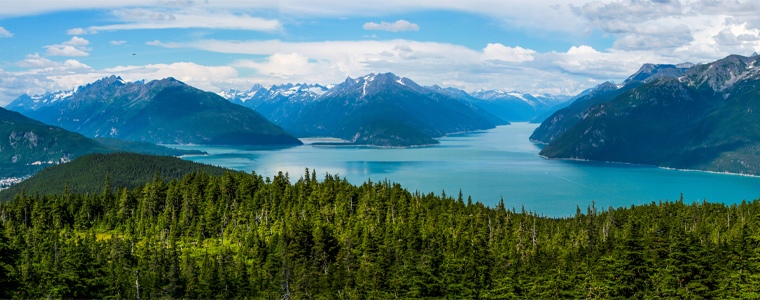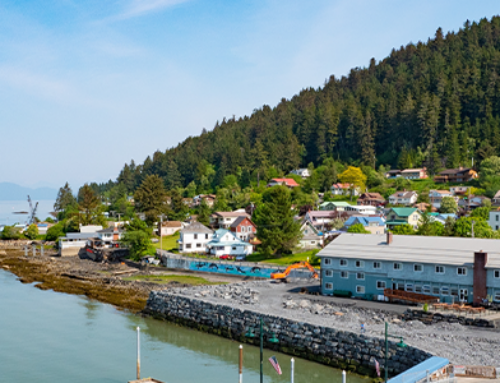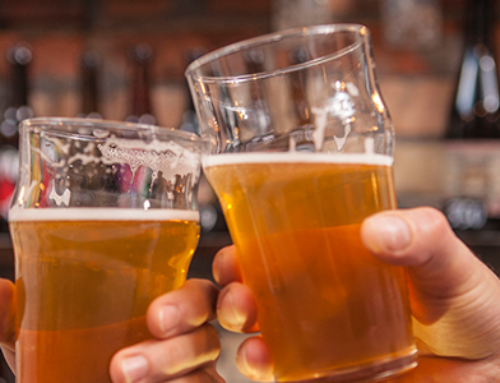What’s piqued your interest about living off-grid in Alaska? Is it the feeling of freedom—the knowledge that you’re completely independent? Is it the fact that you can choose to live absolutely anywhere, even in the middle of the wilderness? Is it that sense of pride that comes from self-sufficiency?
Whatever first attracted you to the idea of living off the grid in Alaska, there comes a time to stop dreaming and start planning.
In other words, let’s talk about exactly what you need to live off the grid in Alaska. We’ll cover five basic necessities—and the not-so-basic versions of each that can make your life a lot easier when you’re no longer using public utilities.
Let’s start with the first thing every Alaska household needs, no matter what.
Off-the-Grid Necessity #1: A Heat Source
There are a few places in the U.S. where you can get by without heat. (Hawaii comes to mind!)
However, Alaska is not one of them.
So, one of the first questions that pops up when buying or building an off-grid home in Alaska is: How will I heat it?
A wood fireplace will be your simplest solution. If you go this route, you’ll also need to build a woodshed or similar structure that can store your wood for the entire winter. (And protect it from the elements!)
If you want to get fancy, you might think about investing in an outdoor wood furnace. Obviously, this will represent a bigger investment than a simple wood stove. Outdoor wood boilers require a significant amount of infrastructure, including pumps and/or fans that need to be powered in some way. However, if comfort is paramount, it might make sense for your setup. Additionally, outdoor wood furnaces can also make hot water and they can be controlled by a thermostat—very handy indeed.
Other options for heating your house include a propane heater, which you can also control by a thermostat. Additionally, you can use your propane supply to run several other types of appliances. (More on that in a minute!)
If you choose a more elaborate setup, it’s always good to have a woodstove and plenty of warm blankets around, just in case something goes sideways.
Off-the-Grid Necessity #2: Water
No matter what, you’re going to need access to some kind of water source when you’re living off-grid. Exactly how you go about it depends on your needs and your budget.
Are You Game for a Dry Cabin?
If you’ve perused any of the off-grid cabin listings in Alaska, you’ve probably seen “dry cabins” for sale or rent.
Dry cabins have no running water. Instead, you fill up a water tank or jug and haul it to your cabin. You can usually buy water in the nearest town—assuming there is one!
Once you get the water to your home, those tanks will be your main source for drinking, cooking, and washing dishes. As for your bathroom duties, those are usually accomplished in an outhouse. Dry cabins also might mean taking cold showers—or rigging up a gravity-powered sun shower.
Can You Collect Fresh Water in Alaska?
In many cases, yes. Streams, rivers, lakes, and groundwater can all act as sources of water for you. However, you may need to secure water rights through Alaska’s Department of Natural Resources (DNR). Water rights transfer when a property is sold, so it’s worth investigating this angle if you’re buying land.
Take steps to purify untreated water before drinking. Parasites like Giardia lamblia and Cryptosporidium are found in Alaska’s waters. Both can be dangerous. The best way to kill both is to boil your water for at least three minutes. This will also take care of bacteria, viruses, and any other parasites. Certain filters will also help—but not all. (Read the instructions!) Boiling is a sure-fire way to protect yourself.
If dry cabin living isn’t for you, you’ll have a couple of other options:
- Dig a well. This can be expensive, and not every piece of property is suitable. If you want to go this route, do your research before closing on a deal.
- Set up a water storage tank with a pump and a pressure tank. You’ll still have to haul water to fill the tank—or set up a catchment system to collect rain water and snow. You’ll also need electricity to power the pump. That said, this can be a much cheaper solution than digging a well, and it can mean the convenience of having pressurized water in your home.
Off-the-Grid Necessity #3: Energy
Even if you’re living a no-frills lifestyle, at certain points, you’re going to need energy to power the items in your off-grid home.
In Alaska, your options for energy independent of the public electric grid include:
Solar Power
The startup costs can be pricey, but solar offers one of the most sustainable solutions out there—as long as you keep your panels clean and clear of snow.
On a basic level, you’ll need:
- Solar panels, installed on some kind of racking system.
- An inverter to convert the DC current from the panel into AC power.
You might also want to invest in a battery system to act as a backup power source when the sun isn’t shining. Although you can operate without one, a battery system can be a lifesaver if you get a string of dark, cloudy days.
A Generator
There are a couple of things that belong in every Alaska household. Many people would argue that a generator is one of them. Even if you’ve got solar power, a generator offers another backup—just in case.
A number of Alaska off-gridders swear by gasoline generators, especially in the dead of winter. However, you’ll also find propane generators in Alaska.
Propane
Finally, propane is also a popular energy source for those living off the grid. It’s an easy way to run appliances like a stove, refrigerator, hot water heater, clothes washer/dryer, and, as we mentioned earlier, even a heater for warmth. In the long run, it’s going to be more expensive than solar, but the startup costs are a lot lower.
Off-the-Grid Necessity #4: A Toilet
Everyone needs a clean, sanitary, and safe place to do their business. Most people in the lower 48 don’t think twice about their toilet situation. However, it’s something you’ll have to plan carefully during your off-grid existence.
Here are your options:
An Outhouse
It’s a pretty simple concept. Dig a hole and enclose it with a structure that offers the user some shelter and privacy. Outhouses run the gamut from pretty basic to pretty fancy, as you’ll see in the video below. Check out the well-appointed outhouse at the off-grid Caribou Lodge near Talkeetna:
By the way, the Alaska Division of Water has some pretty handy guidelines for building your outhouse or “pit privy” in legalese. Make special note of the setback requirements to avoid contaminating groundwater.
A Bucket Toilet
Also known as a “honey bucket,” the bucket toilet is your most basic option. It’s ready in an instant, and there’s not much up-front investment cost. However, honey buckets leave you with the challenge of properly disposing of your waste. Depending on where you live, there may be a designated honey bucket area at a nearby sewage lagoon or a designated honey bucket trench at your closest landfill.
If you decide to go this route, take care to dispose of your waste properly. This will prevent human and animal contact with human waste, which can pose a significant health risk.
A Composting Toilet
More expensive than your average bucket—but also significantly less trouble—are composting toilets. Did we mention that composting toilets also produce barely any odor? Some even have significant enough capacity that you may not have to empty them more than once a month.
Are composting toilets legal in Alaska? They’re not specifically addressed in state law. However, some local jurisdictions in Alaska do mention either “proper waste disposal” or “alternative toilets.” Make sure you check all applicable regulations before going this route.
An Incinerator Toilet
Although incinerator toilets are an option for off-grid homes, they also come with a significant downside: They draw a lot of power. This may not be practical for your setup. For many people, though, the ease of the incinerator toilet—which simply burns human waste to ash—feels worth it. The up-front investment and the power draw can be a no-go for many off-the-gridders.
Off-the-Grid Necessity #5: Food
Living off the grid doesn’t necessarily mean living off the land. Plenty of people continue to buy food. However, the off-the-grid lifestyle will impact your food choices.
Here’s what we mean:
- If your off-the-grid journey brought you to a remote area, you’ll probably want to minimize your trips to restock your food supplies.
- During times when you need to conserve power—for example, during the darker winter months if you’re relying on solar—you may decide to use different cooking methods that use less fuel or power.
- Finally, when you’re living with limited refrigeration, you’ll need to think differently about storing your food.
As a result, you’ll want to consider the following:
- Canning and preserving food so you can store items for long periods of time without refrigeration.
- Fishing and hunting as a regular food source, when and where possible.
- Setting up a garden as an additional source of food. It may take a few seasons to dial in your crops, so make sure you have a backup plan initially.
- Raising animals for meat like rabbits and pigs. Goats can be both a source of meat and dairy. Chickens can also provide you with meat and eggs.
All of these will contribute to greater self-sufficiency—and give you more freedom to decide when (and if) you want to head to the nearest town for supplies.
Finally, One More Note About Off-Grid Living: Financing
Financing isn’t something that every aspiring off-gridder will need. You may have stored up a nest egg that’s sufficient to fund your dream.
However, if you need a loan to finance your off-grid home, it’s not as easy as securing a regular home loan. Many banks are reluctant to lend money for homes that aren’t connected to the electrical grid and/or ones that don’t have running water. In other words, you’ll find it difficult to qualify for a traditional mortgage through a large bank.
Instead, try talking to a local credit union. You may end up paying a penalty for a non-traditional mortgage, but you may not have much choice if you need to borrow money.
You might also consider owner financing. Some owners in Alaska offer you this option, which usually involves making a down payment, followed by installments. If you enter into this type of agreement, make sure to read all of the fine print. Some contracts include a significant balloon payment after a certain period of time. Make sure you’re able to cover it when it’s due.
Your Dream Life, Off the Grid in Alaska
If the pride and freedom of self-sufficiency are driving your off-the-grid dreams, you’ll be in good company in Alaska. You’ll also find plenty of people content to live life on their terms, without the pressures of “normal” society. In other words, if you’re looking for a place to pave your own path, there’s no better place in the U.S. than Alaska.
Need some help moving to your off-grid home? We can help you get everything you need to your site—even if you’re in a remote area. Just reach out to one of our experts to start a free quote. We’d be happy to help you make your off-grid dreams come true.
Tell us about your move!
 (907) 868-4756
(907) 868-4756


